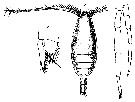
Issued from : T. Scott
in Rep. Fishery Bd Scotl., 1902, 20 (3). [Pl. XXII, Figs. 5-7].
Male (from Shetland Islands): 5, habitus (dorsal); 6, P5; 7, terminal part of P5.
Prosome about equal to half the length of body.
Abdomen narrow, its length is equal to little more than 1/3 of that of prosome; 5-segmented.
Genital segment slightly longer than any of the others abdominal segments.
Anal segment very short.
Caudal rami very short.
A1 appear to be the same on both sides, do not reach to the end of the abdomen; first 6 segments short, 7th, 8th and 9th partly coalescent, 10th to 15th segments of moderate length, sub-equal, 17th segment also nearly equal to these length, but the remaining segments rather shorter.
P5 very simoilar to those of
Phaenna spinifera. The right leg is elongated and slender and 4-segmented, the first three are of nearly equal in length, but the last is about one and a half times the length of the preceding segment and considerably attenuated so as to resemble a spine rather than a segment. The left leg is rather longer than the right one and apparently 5-segmented; the terminal portion consists of 2 appendages, the inner one being short and moderately broad, rounded at the end and fringed with setae, the other is narrow and longer than the inner one and forms with it a kind of finger and thumb-like arrangement (fig.7). P5 are seen to differ somewhat from the male of
Phaenna spinifera especially in the terminal part of the left leg when compared with the figure of the male P5 in Giesbrecht.




